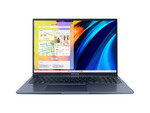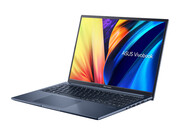Asus Vivobook 16X M1603, R7 5800H
Spécifications de l'ordinateur portable

Price comparison
Critiques pour le/la Asus Vivobook 16X M1603, R7 5800H
Source: Laptop Media
 EN→FR
EN→FRWhen you want a laptop that has the performance of a big gaming machine, you need to make sacrifices. Especially if you want it to be affordable. Well, this is exactly the case with the Vivobook 16X (M1603). Its IPS panel has a WUXGA resolution, 16:10 aspect ratio, comfortable viewing angles, and a good contrast ratio. Its backlight doesn’t use PWM for brightness adjustment, but on the other hand, the color coverage is only 50% of the sRGB color gamut. Although the laptop is made out of plastic, it has one strong feature when it comes to the body – its coating. ASUS has covered all body panels with an antimicrobial layer, which attracts all microbes and then kills them off. Quite sadistic, but also beneficial. In addition to that, the port selection is robbed of an SD card reader, while the USB Type-C port can only be used for data transfers. Also, some of the memory (8GB to be precise) has been soldered to the motherboard. Further expansions are possible via the single SODIMM slot. In terms of battery, you get between 8 and 10 hours on a single charge, depending on your activities – watching videos, or browsing the Web. Using more demanding software, however, will drain it significantly more quickly, due to the power-hungry processor. Speaking of which, it is really powerful. Even though it is a couple of generations old, one can still reap the benefits of AMD’s bold design back in the day. So, if you are looking for a machine that is capable of delivering all you need, at a low price, and still allows you to play light games – get the Vivobook 16X (M1603). Don’t miss to check out the OLED version of this device.
Critique simple, disponibles en ligne, Très longue, Date: 02/23/2023
Source: Laptop Media

Soutien, disponibles en ligne, Très courte, Date: 02/23/2023
Commentaire
AMD Vega 8:
Carte graphique de la série Ryzen, basée sur l'architecture Vega avec 8 unités de calcul (512 nuanceurs) et montant à 1 750 MHz).
Ces cartes devraient être capables de faire tourner tout les jeux d'aujourd'hui, mais la plupart d'entre eux uniquement en détails moyens ou faibles et avec des résolution basses. Les plus vieux jeux ou les jeux moins gourmands restent jouables avec de beaux graphismes.
>> Plus d'informations sont à trouver dans notre comparaison des cartes graphiques mobiles et ainsi que dans notre liste des Benchmarks affiliés.
R7 5800H:
APU mobile octa-core utilisant les cœurs Zen 3 cadencés à 3,2 à 4,4 GHz et une carte graphique Vega avec 8 CU cadencées jusqu'à 2000 MHz.
>> Plus d'informations sont à trouver dans notre comparaison des processeurs mobiles.




